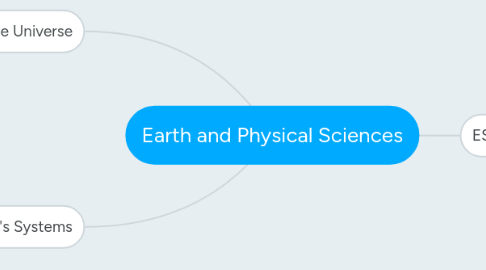
1. ESS1: Earth's Place in the Universe
1.1. ESS1.A: The Universe and its stars
1.1.1. patterns of motion (sun, moon, stars)
1.1.2. the sun is a star, closer that others, and is changing
1.1.3. universe began with a bang
1.2. ESS1.B: Earth and the solar system
1.2.1. patterns of seasons
1.2.2. patterns of orbit
1.2.3. gravity in solar systems
1.2.3.1. Kepler
1.3. ESS1.C: The history of planet Earth
1.3.1. cycles vs events
1.3.2. changes over time
1.3.2.1. earthquakes
1.3.2.2. rock strata
1.3.2.2.1. measures
2. ESS2: Earth's Systems
2.1. ESS2.A: Earth materials and systems
2.1.1. effect of wind and water
2.1.1.1. geosphere
2.1.1.2. hydrosphere
2.1.2. energy cycle
2.1.2.1. feedback loops
2.2. ESS2.B: Plate tectonics and large-scale system interactions
2.2.1. mapping of land and water shapes
2.2.1.1. bands of earthquake and volcano activity
2.2.2. unifying theory explaining movement of Earth's surface
2.2.2.1. as the surface expression of mantle convection
2.3. ESS2.C: The roles of water in the earth's surface processes
2.3.1. water as solid, liquid
2.3.1.1. found everywhere
2.3.1.2. flows
2.3.1.3. cycles
2.4. ESS2.D: Weather and climate
2.4.1. combination of wind, sunlight, precipitation, and temperature
2.4.1.1. weather - daily
2.4.1.2. climate - pattern over time
2.4.2. influence of oceans in redistribution
2.4.3. role of the sun
2.4.4. changes over time
2.4.4.1. human activity and carbon dioxide
2.5. ESS2.E: Biogeology
2.5.1. plants and animals dependence on environment
2.5.2. plants and animals effects on environment
2.5.3. continual co-evolution of earth and life
3. ESS3: Earth and Human Activity
3.1. ESS3.A: Natural resources
3.1.1. required for life
3.1.1.1. land
3.1.1.2. oceans
3.1.1.3. atmosphere
3.1.1.4. biospehere
3.1.2. some renewable, others not
3.1.3. availability impacts society and human development
3.2. ESS3.B: Natural hazards
3.2.1. severe weather
3.2.2. natural processes
3.2.2.1. earthquakes, volcanos
3.2.2.2. floods, erosion
3.2.3. characteristics
3.2.3.1. some may be predicted
3.2.3.2. cannot be prevented
3.2.4. shape society and human development
3.3. ESS3.C: Human impacts on Earth systems
3.3.1. recycle, reduce, reuse
3.3.2. alterations of the biosphere
3.3.2.1. extinctions
3.3.2.2. habitat damage
3.3.3. sustainability
3.3.3.1. preserve biodiversity
3.4. ESS3.D: Global climate change
3.4.1. threat of Earth's global mean temperature rise
3.4.1.1. human activities
3.4.1.1.1. greenhouse gases
3.4.2. offsets
3.4.2.1. science
3.4.2.2. engineering
3.4.2.3. understanding and behavior
